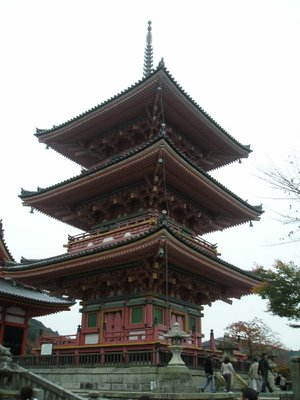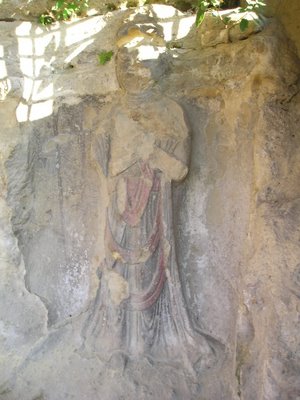
Japan is paradise for noodle guzzlers like me where noodles are as popular as the Filipino’s everyday kanin. There are 3 types of Japanese noodles: (1) udon which is made from wheat flour, light in color and thicker than soba; (2) soba which is thin, long, brownish and made from buckwheat flour; and (3) ramen which is actually Nipponized Chinese noodle. The first 2 are usually served in hot soup or dipped in cold shoyu soup, always garnished with minced onion, and spiced with preferred condiments (i.e. spices, pepper). I was introduced to them at JICA’s Osaka International Center where I stayed for 2 nights after arriving in Japan. My encounter with ramen came at the later part of my stay in Japan during my last visit to Nagoya’s Osu Kannon Temple. It is a close relative of the Filipino mami (the Chinese connection) with miso broth. The garnish is very diverse: bamboo shoots (read: labong), bean sprouts (read: toge), thin roasted pork (or beef and chicken) slices, etcetera. What I had at Osu Kannon Temple is actually hybrid ramen: yellow thin Chinese egg noodles in hot soup garnished with thin pork slices, fermented (read: buro) bamboo shoots, chopped onions, and raw egg. Whatever, Japanese noodles are really oishii.



In Nagoya, I was determined to hunt down its 2 most popular noodle dishes. I had the Miso Udon Stew in Osu Kannon Temple’s shopping arcade during one of its famous flea market days. The noodle was served piping hot in a large bowl that I thought was good for 3 persons. It was 2 o’clock in the afternoon and I was really very hungry so I wolfed it down to the last drop of soup and washed it with a cold bottle of Asahi dry beer. The fresh unsalted noodles blended well with the tanginess of the chopped spring onions, the earthy flavor of the chopped chicken, and the musky dark miso-based sauce. A week later, I had Kishimen where it is traditionally served at the Atsuta Shrine. The noodles are flat and smooth in texture, excellently complimented by abura-age (deep fried tofu), assorted green vegetables, dried bonito shavings, and seasoned with tsuyu (light soy sauce).


The local favorite in Japan’s southern tip at Oita is Dango-jiru. On our first day there, UNCRD’s Toga-san and Takai-san, and Ogino-san took me to a small but popular restaurant along the historic Renga Building when they heard of my noodle fetish. The main ingredient is dumpling noodles made by mixing flour with water and salt then cooked in a soup of miso, carrots, onions, and burdock. I really regretted having missed the equally popular Yaseuma snack which is wheat noodles sprinkled with sugar and dipped in soy flour and, 1 week back, Ise’s thicker-than-usual udon in a thicker-than-usual sauce. But as the saying goes, you can’t have it all.

My noodle dinner in Kyoto will be the Tsukimi-soba (soba with raw egg) perfectly served with a hot cup of Japanese green tea and a bottle of cold sake. It was actually a combination of a late lunch and an early dinner because I was too busy enjoying Kyoto that I forgot to eat. I have been to the old city’s world heritage sites, I had touched the happy stone, and my stomach is full of soba fermenting in sake and green tea. It is indeed a beautiful life.

I started my day in Japan with an initiation to its noodle cuisine (my first dish in Osaka is Udon to be exact). It is but fitting to end it with a nice noodle meal. And JICA and UNCRD which I have heckled throughout the training course for not serving Japanese food in JICA Chubu obliged me (and my co-trainees) during our testimonial lunch with an array of sushi (both the restaurant and homemade varieties), tempura, and a tray of wonderful soba noodles with cold shoyu soup served in small cute Japanese bowls. “You have to eat all of that,” Baku-san told me with a grin, pointing at the noodle tray. God knows how I did tried.

I started my day in Japan with an initiation to its noodle cuisine (my first dish in Osaka is Udon to be exact). It is but fitting to end it with a nice noodle meal. And JICA and UNCRD which I have heckled throughout the training course for not serving Japanese food in JICA Chubu obliged me (and my co-trainees) during our testimonial lunch with an array of sushi (both the restaurant and homemade varieties), tempura, and a tray of wonderful soba noodles with cold shoyu soup served in small cute Japanese bowls. “You have to eat all of that,” Baku-san told me with a grin, pointing at the noodle tray. God knows how I did tried.

PHOTOS (top to bottom):
1) A noodle restaurant at an Osaka mall.
2-3) JICA Osaka Center’s version of the Udon and Soba.
4-5) Osu Kannon’s Ramen and Miso Edon.
6) Atsuta Shrine’s Kishimen.
7) My Dango-jiru in Oita.
8) My Tsukimi-soba lunch-dinner with green tea and sake at Kyoto’s Kiyomazudera Temple.
9) Soba in cold shoyu soup served during our testimonial lunch at the JICA Chubu Center.





















